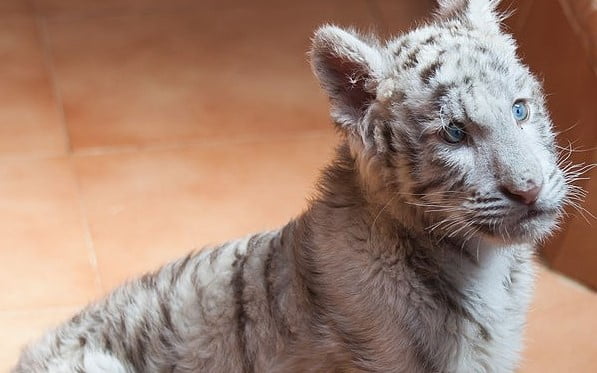White Tigers: The not so colourful truth
The images of furry, blue-eyed, white tiger cubs can pull at even the toughest of heart strings. By some in the zoo community they are seen as a successful attraction and white tigers can be found in institutions across the globe. But there has been much criticism against the keeping of these white tigers and a call for more transparency on the truth behind why there is such concern.
White tigers originate from Bengal tigers. The Bengal tiger is a tiger that everyone can recognise, it is orange in colour and has dark stripes. But as a result of a recessive gene trait, the gene which controls coat colour, white Bengal tigers can naturally occur – albeit very, very rarely, they will usually have a white coat colour and blue eyes. There have been documented sightings of them in the wilds of India as far back as the 15th century and one day, so the story goes, someone plucked one of these unusual cubs from its natural home, and its legacy lives on, in the existing global population of captive white tigers.
For white tigers to currently exist in such numbers in captivity, they have been repeatedly inbred – and we all know what that means. In fact, in the Australasia Zoo Aquarium Association (ZAA)’s position statement on white lions and tigers, it says: ‘Due to their uniqueness they are often selectively bred, which can lead to health problems. Health problems may be more frequently encountered due to the inbreeding which is typically required to maintain the white characteristic. They include cleft palates, immune deficiencies, mental impairments, spinal problems and issues with lung development.’
The ZAA goes on to say that within the southern hemisphere white tigers can be at more risk from UV-related skin conditions (including cancer) due to the lack of skin pigmentation. The British and Irish Association of Zoos and Aquariums (BIAZA) has similar condemnation for the purposeful breeding of white tigers, saying in its position statement that “the delivery of thoughtful, educational messages about the unfortunate results of inbreeding”, must form part of any public display where a member facility comes to hold and care for such animals. In 2011 the US Association of Zoos & Aquariums (AZA) officially banned the breeding of white tigers by their member zoos. There must be good reason for so many major zoo associations to not want its members to breed white tigers.
Why then, when purposefully maintaining a population of these white anomalies, which can have seriously compromised health and therefore welfare, do institutions continue to do it? Because people love them. They are adorable. They are just so cute. And when you engage that level of desire for an animal then ultimately you must be able to get people to part with their money, right? Right. And this money can go towards conservation and further education.
However despite this, the wild tiger populations are still declining. Despite huge conservation efforts the IUCN Red LIST website states that in 1998, the global tiger population was estimated to be between 5,000 and 7,000 individuals – it could now stand at as few as 2,500 mature individuals. The tiger faces many threats; trade in body parts, poaching, habitat encroachment, human conflict. What is vital is that organisations ensure their conservation funds support effective, measured and valid practices. Most, if not all tiger conservation organisations actively discourage the breeding of white tigers. They have mixed ancestry. They are genetically compromised. Their lack of genetic diversity serves no practical conservation purpose and they cannot be used in captive breeding or reintroduction programs. So even if an institution just purchases white tigers instead of actually breeding them, they have still fuelled the breeding enterprise. Many white tigers are bred that are unsuitable for trade and therefore have to be euthanased (born with deformities, it is reported that as many as 30 to 60 cats may be destroyed in order to get one perfect-looking, profitable cub).
Zoos have stated that white tigers can act as ambassadors for their wild cousins. And white tigers are absolutely stunning, of that there is no question. When that first cub was spotted in the wild in India it must have taken someone’s breath away. But their beauty and attraction is misleading and sends a confusing message to the public. White tiger use misses the point when it comes to conserving ‘real’ tigers in the wild and it serves no practical conservation purpose.
Image © Luis Miguel Bugallo Sánchez (Lmbuga) -own work (CC BY-SA 3.0) via Wikimedia Commons





